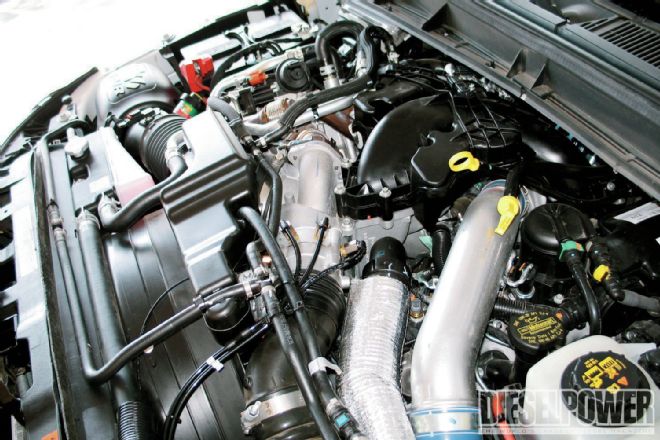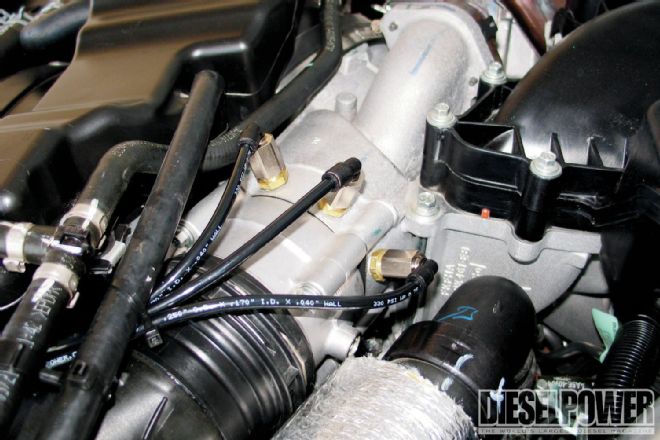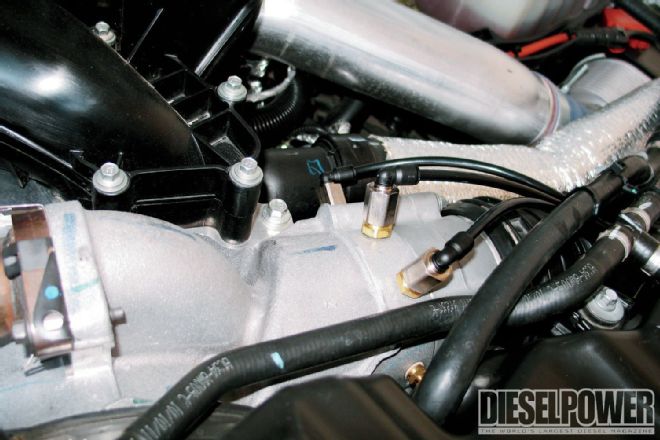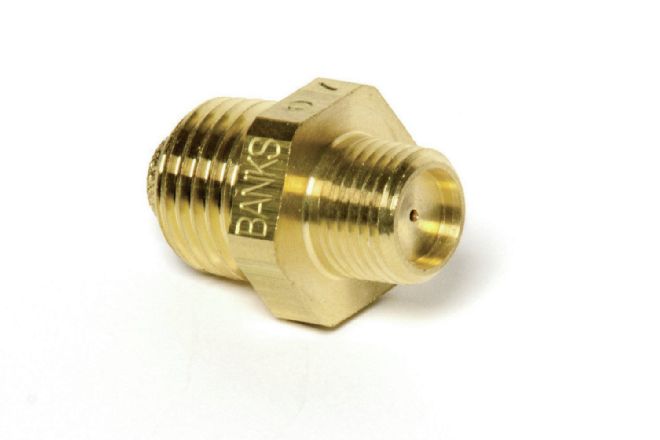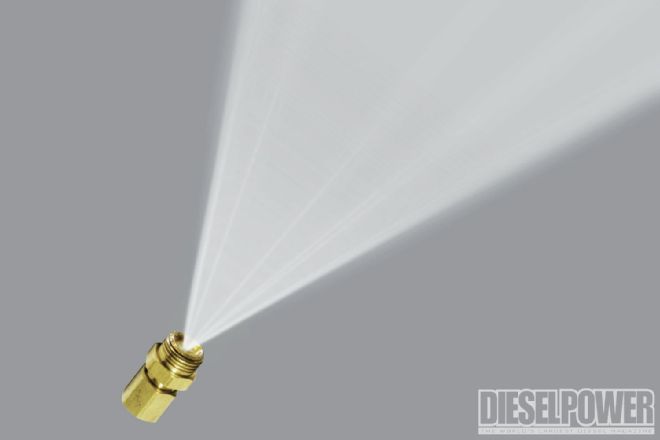It may seem too good to be true, but injecting a mix of water and methanol into a diesel engine can increase horsepower and torque, improve fuel economy, and lower exhaust gas temperature (EGT) and NOx emissions. The “magic” happens when the additives super-cool the intake charge so the fuel can be burned more completely (along with the addition of some extra hydrocarbon molecules). This trickery is how you get more power without using more diesel fuel.

| This ’12 Ford F-450 gained 120 hp and 185 lb-ft of torque after the installation of a DoubleShot dual-stage Banks StraightShot water-methanol injection system. With the system tuned for maximum performance, the 4-ton-plus truck struggled to keep traction off the line and would noticeably push your back into the seat when the throttle was pinned.
The team at Banks Power has dyno-tested their new StraightShot water-methanol injection system and found it can add up to 120 hp and 185 lb-ft of torque to a 6.7L Power Stroke with stock programming. Now, the same water-methanol injection system used to propel a Freightliner race truck up Pikes Peak Mountain is available to the public.
Water-Methanol Magic The technology was used on WWII aircraft and was even available on the ’62 Oldsmobile Cutlass Jetfire with its turbocharged 215ci V-8 that used “Turbo-Rocket Fluid.” Like a modern diesel, the all-aluminum engine had a turbo mounted in the valley, and when the water-methanol kicked in, the engine produced “one hustling horsepower for every cubic inch of displacement.” Check out the classic Jetfire ad on YouTube to learn how the “phenomenal” engine works, and you’ll get to see some great reactions of the actors as they experience “true, high-compression performance.”
Although the gasoline Olds Jetfire never really caught on, water-methanol injection has been popular in racing. Just because the manufacturers have not re-embraced this power-adding technology, there’s no reason you can’t take advantage of its benefits. Whether you have a late-model car, truck, or SUV with all the modern emissions equipment, or an old indirect-injection (IDI) engine, water-methanol injection is a relatively safe way to easily increase your diesel’s power, and now Banks Power has a full lineup of products for you to choose from.
Total Control
At the heart of the Banks water-methanol injection system is the StraightShot electronic interface that performs multiple tasks. Even with its ability to perform complex operations, the controls and display are designed with the keep-it-simple philosophy in mind. The controller puts the driver in charge of up to two stages of injection that can be based on boost pressure, throttle position, and exhaust gas temperature—or a combination thereof. The stages are not stepped, as with competing products, but are fully adjustable to suit your needs whether you are racing, towing, or daily driving. You tell the StraightShot how you’d like it to operate (for example, having it kick in when a certain EGT and throttle position is reached), and the controller will instantly calculate how to make the water-methanol injection events smooth and progressive.

| The StraighShot is available in various trim levels and is shown here with an EGT sensor, a 7-gallon tank, four brass injection nozzles, the StraightShot controller, an injection solenoid, and all the wiring, plumbing, and brackets you need for a clean installation.
While we were driving the Ford F-450 seen in the photos, the two-stage DoubleShot version of the system worked seamlessly, as if it were factory equipment. The power delivery was smooth and even, making it feel like the truck had just come from the factory with more than enough power to roast all four rear tires. With the touch of a button, the system was disabled and the truck instantly went back to its stock power level of “only” 661 lb-ft of torque at the rear wheels (which was actually a letdown after the E-ticket ride we had experienced just seconds earlier).
Pump It Up
The water-methanol is injected into the engine through brass nozzles designed to completely atomize the mix over a wide range of pressures. You can choose from 10 different flow rates to customize the output for your needs. The fluid is moved with a 300-psi pump that has safety features that can detect if there is a leak or if the water-methanol is low. Delivery of the fluid is controlled by a low-restriction stainless steel solenoid and check valve (or two for dual-stage systems) with a 3⁄16-inch orifice. The plumbing uses nylon tubing and EPDM seals that are methanol-compatible and rated to handle 300 psi at high temperatures. The nozzle fittings swivel 360 degrees to make it easy to install the tubing cleanly. Water-methanol tanks are available in sizes from ¾ gallon up to 7 gallons, or you can even run the system using your existing windshield washer fluid reservoir.
Adding 120 hp at Home
Banks’ system is designed to be easy to install, which means you can add 120 hp without ever leaving your driveway. The wiring is designed to be plug-and-play, so you don’t have to cut any of the wires in your truck, and the tubing and fittings use push-lock connections that don’t require tools to connect or take apart.

| 2012 Ford F 450 Burnout
The F-450 we drove had the water-methanol tank mounted inside of a locking toolbox, which made the system virtually invisible from the outside. The 300-psi pump was mounted under the driver side of the cabin, and the solenoids were attached to the radiator support behind the headlamp. From there, the tubing was routed to three ports drilled into the intake manifold, with everything being controlled by the StraighShot module mounted in the A-pillar next to the windshield, with the wiring coming through the firewall alongside the factory wires.
In total, this installation only required drilling a few holes and mounting the tank, the pump, the nozzles, and solenoids—in addition to running some tubing and a minimal amount of wires. So, it’s a relatively simple setup when compared to how much instant power it can add to your truck. The system is also not limited to just pickups; there is a universal version of the kit designed for motorhomes, SUVs, and even gasoline-powered vehicles (whatever those are).
A pump that is capable of producing 300 psi is included in the StrightShot system. In this installation, the pump was hidden under the truck, next to the framerail. The plumbing uses quick connects, and the mounting bracket has a rubber isolator to prevent the pump activity from transferring noise to the cabin.
